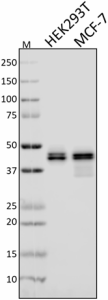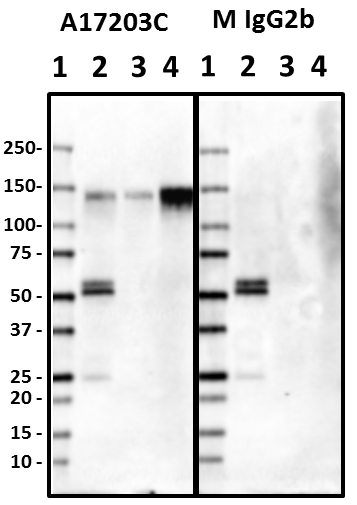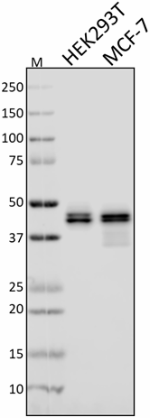- Clone
- 1H9-2 (See other available formats)
- Regulatory Status
- RUO
- Other Names
- ATX3, ATXN3, MJD, Machado-Joseph disease protein 1, SCA3, Spinocerebellar ataxia type 3 protein, JOS, josephin
- Isotype
- Mouse IgG2a, κ
- Ave. Rating
- Submit a Review
- Product Citations
- publications

-

Whole cell extracts (15 µg protein) from HEK293T and MCF-7 cells were resolved on a 4-20% Tris-glycine gel, transferred to a nitrocellulose membrane and probed with 1.0 µg/mL (1:500 dilution) of Purified anti-Ataxin-3 Antibody, clone 1H9-2, overnight at 4°C. Proteins were visualized by chemiluminescence detection using HRP goat anti-mouse IgG Antibody (Cat. No. 405306) at a 1:3000 dilution. Lane M: Molecular Weight marker.
| Cat # | Size | Price | Quantity Check Availability | Save | ||
|---|---|---|---|---|---|---|
| 650401 | 25 µg | 100€ | ||||
| 650402 | 100 µg | 212€ | ||||
Ataxin-3 is an ubiquitously expressed protein which contains a poly-glutamine tract. Genetically abnormal expansion of the poly-glutamine repeats results in accumulation of ubiquitinated ataxin-3 protein aggregates and leads to a neurodegenerative disorder, Machado–Joseph disease (MJD). The protein has ubiquitin interacting motifs and a N-terminal Cysteine residue (C14) responsible for its deubiquitinating activity. Ataxin-3 binds and hydrolyzes polyubiquitinated proteins, and interacts with key proteasome components, such as p97/VCP and p45, indicating that Ataxin-3 may play functional roles in ubiquitin-proteasome system. The protein also act as a transcriptional repressor when interacting with transcriptional activators and coactivators.
Product DetailsProduct Details
- Verified Reactivity
- Human
- Antibody Type
- Monoclonal
- Host Species
- Mouse
- Immunogen
- Full length Ataxin-3 recombinant protein
- Formulation
-
This antibody is provided in phosphate-buffered solution, pH 7.2, containing 0.09% sodium azide.
Previous lots of this product may have been formulated with 0.1% or 0.05% NaN3 instead of 0.09% NaN3. For further information please contact BioLegend Technical Support or Customer Service. - Preparation
- The antibody was purified by affinity chromatography.
- Concentration
- 0.5 mg/ml
- Storage & Handling
- Upon receipt, store undiluted between 2°C and 8°C.
- Application
-
WB - Quality tested
- Recommended Usage
-
Each lot of this antibody is quality control tested by Western blotting. Western blotting, suggested working dilution(s): Use 0.5 µg per ml antibody dilution buffer for each mini-gel. It is recommended that the reagent be titrated for optimal performance for each application.
-
Application References
(PubMed link indicates BioLegend citation) -
- Zhou L, et al. 2013. Neuroscience. 23:243. PubMed
- Product Citations
-
- RRID
-
AB_10900236 (BioLegend Cat. No. 650401)
AB_10900236 (BioLegend Cat. No. 650402)
Antigen Details
- Structure
- 364 aa with predicted molecular weight of 42 kD. The protein contains highly polymorphic polyglutamine repeats and has two isoforms which contain 2 or 3 ubiquitin interacting motifs (UIMs).
- Distribution
-
Nuclear
- Function
- Has transcriptional repression activity through interaction with regulators of transcription and histones. It regulates ER-associated protein degradation and autophagy when interacts with p97/VCP. It also contains deubiquitination activity.
- Interaction
- Ataxin-3 interacts with ubiquitin, p97/VCP, histone acetyl-transferases (p300, CBP, and PCAF), and histone.
- Biology Area
- Cell Biology, Chromatin Remodeling/Epigenetics, Transcription Factors, Ubiquitin/Protein Degradation
- Antigen References
-
1. Kawaguchi Y, et al. 1994. Nat. Genet. 3:213.
2. Mao Y, et al. 2005. P. Natl. Acad. Sci. USA 102:12700.
3. Li F, et al. 2002. J. Biol. Chem. 277:45004.
4. Zhong X, et al. 2006. Hum. Mol. Genet. 15:2409.
5. Tait D, et al. 1998. Hum. Mol. Genet. 7:991. - Gene ID
- 110616 View all products for this Gene ID
- UniProt
- View information about Ataxin-3 on UniProt.org
Related Pages & Pathways
Pages
Other Formats
View All Ataxin-3 Reagents Request Custom Conjugation| Description | Clone | Applications |
|---|---|---|
| Purified anti-Ataxin-3 | 1H9-2 | WB |
Customers Also Purchased

Compare Data Across All Formats
This data display is provided for general comparisons between formats.
Your actual data may vary due to variations in samples, target cells, instruments and their settings, staining conditions, and other factors.
If you need assistance with selecting the best format contact our expert technical support team.
-
Purified anti-Ataxin-3

Whole cell extracts (15 µg protein) from HEK293T and MCF-7 c...

 Login / Register
Login / Register 








Follow Us